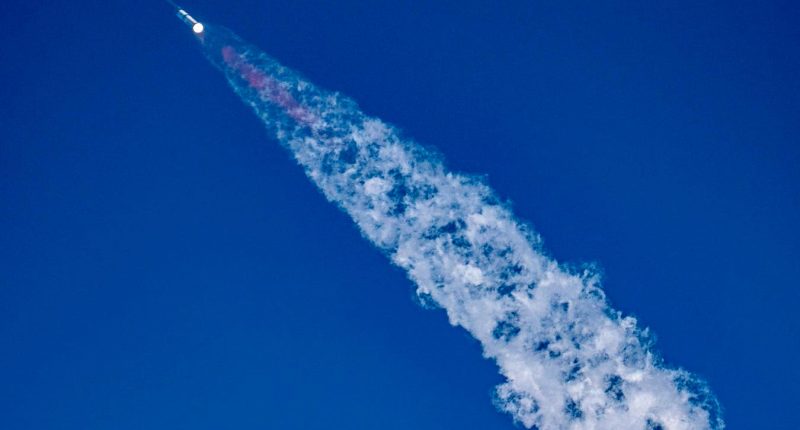Share this @internewscast.com
The SpaceX Starship rocket launches from Starbase, Texas, as seen from South Padre Island on May 27, … More
AFP via Getty Images
Elon Musk’s SpaceX launched its ninth flight test of the Starship vehicle and Super Heavy booster on Tuesday, May 27, but the Starship vehicle broke up over the Indian Ocean 46 minutes after launch.
It came after Super Heavy was lost in the Gulf of Mexico instead of returning to the launch pad. It was the first time the reusable rocket had been reused.
A two-part launch vehicle, Starship is designed to carry 100 tons to Mars or transport up to 100 people on long-duration, interplanetary flights, according to SpaceX. The vehicle could also be used for point-to-point flights, reducing times for most international trips to just 30 minutes.
SpaceX Starship Flight Test 9: What Happened To Super Heavy
Flight Test 9 lasted significantly longer than the two previous tests, both of which ended abruptly with Starship exploding over the Caribbean. This time, Starship reached the Indian Ocean before engineers lost contact.
The test began with its launch at 6:36 p.m. CDT, after which Super Heavy flew at a higher angle of attack during its descent back to Earth, according to SpaceX, to increase atmospheric drag on the vehicle and thereby reduce propellant use. However, as it relit its engines to land just six minutes after launch, it experienced a “rapid unscheduled disassembly.” Despite the mishap, SpaceX called its first-ever reuse with a first flight-proven Super Heavy a “major milestone.”
Super Heavy is designed to be fully reusable and has already been caught in “chopsticks” three times since the first successful test on Oct. 13, 2024. Starship is also designed to land, though that has not been tested yet.
The SpaceX Starship rocket launches from Starbase, Texas, as seen from South Padre Island on May 27, … More
AFP via Getty Images
SpaceX Starship Flight Test 9: What Happened To Starship
Starship refers to the upper part of the rocket, where cargo — such as satellites or humans — would be carried, with the section underneath called the Super Heavy booster. When stacked on the launch pad, the entire vehicle stands around 403 feet (123 meters) tall.
During this test flight, Starship itself launched perfectly for the eighth consecutive time and reached orbit, but plans to deploy a payload of satellites stalled when the payload bay door failed to open. Instead of a controlled splashdown in the Indian Ocean, Starship leaked fuel, spun out of control, and made an uncontrolled reentryEngineers lost contact 46 minutes into the flight 46 minutes into the flight, likely disintegrating over the Indian Ocean. Debris was expected to fall within the planned hazard area in the Indian Ocean, according to SpaceX.
“As if the flight test was not exciting enough, Starship experienced a rapid unscheduled disassembly,” read a SpaceX tweet. “With a test like this, success comes from what we learn, and today’s test will help us improve Starship’s reliability as SpaceX seeks to make life multi-planetary.”
What Happened During Previous SpaceX Starship Test Flights
Starship’s eighth flight test launched on Mar. 6. After engine problems, it ended in “rapid unscheduled disassembly,” after which debris was seen from Florida to the Caribbean. According to SpaceX, approximately five and a half minutes into its ascent burn, a flash occurred in one of the engines, resulting in an “energetic event” that led to the loss of the engine. The vehicle was lost nine and a half minutes into the flight. That followed a similar ending on Jan. 17, when Starship broke up near Haiti. Starship was also tested twice in 2023 and four times in 2024.
When Is The Next SpaceX Starship Test Flight?
The Federal Aviation Administration announced in early May that it was increasing the permitted launches per year for Starship from five to 25. It could mean a rapid uptick in Starship testing as preparation continues for its use by NASA for its Artemis III mission, which aims to land two astronauts on the moon in 2027 and, possibly, lead a private mission to Mars.
Wishing you clear skies and wide eyes.









